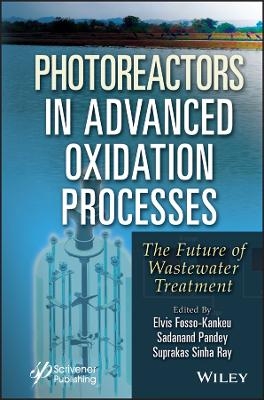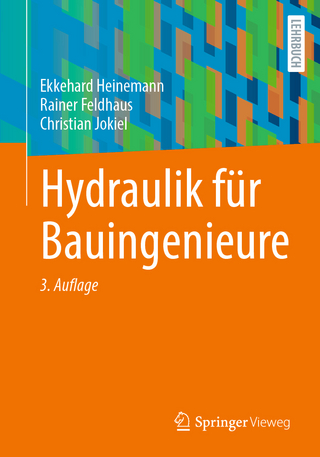
Photoreactors in Advanced Oxidation Process
Wiley-Scrivener (Verlag)
978-1-394-16629-9 (ISBN)
- Lieferbar
- Versandkostenfrei
- Auch auf Rechnung
- Artikel merken
In this book, the editors present the most up-to-date research on Advanced Oxidation Processes (AOPs) to make the argument that AOPs offer an eco-friendly method of wastewater treatment. In addition to an overview of the fundamentals and applications, it provides ample details of the reactive species involved in AOPs as well as reactor design concepts, thus providing readers with the necessary tools to better understand and implement these methods. Moreover, this book presents some conventional and novel photoreactors equipped with UV/vis lamps for working under solar radiation for wastewater treatment in a laboratory and on an industrial scale, which is an important focus of the book.
Readers will find in this book:
In-depth coverage of the performance of sustainable eco-friendly and low-cost heterogeneous photocatalysts (biogenic photocatalysts);
A state-of-the-art fundamental review of parameters affecting photoreactor designs for the effective performance of reactive species;
Identifies, formulates, and analyzes developed processes and technologies to meet desired environmental protection needs of society and formulates solutions that are technically sound, economically feasible, and socially acceptable.
Audience
This book will be of interest to academic researchers and graduate students from the fields of environment, chemistry, and engineering, and professionals including environmental managers in industry, water treatment plants managers and operators, water authorities, government regulatory bodies, and environmentalists.
Elvis Fosso-Kankeu, PhD, has a doctorate degree from the University of Johannesburg in South Africa. He is currently a Full Professor in the Department of Electrical and Mining Engineering, Pretoria, South Africa. His research focuses on the prediction of pollutant dispersion from industrial areas and the development of effective and sustainable methods for the removal of inorganic and organic pollutants from polluted water. He has published more than 220 journal articles, books, book chapters, and conference proceeding papers. Sadanand Pandey, PhD, is a Research Professor in the School of Chemistry and Biochemistry, Yeungnam University, South Korea. He was a Kothari fellow at the world-prestigious Indian Institute of Science (2011–2013) and NRF scientist at the University of Johannesburg, South Africa (2014–2018). His research activities span the disciplines of polymer chemistry, nanotechnology, and sustainable and advanced materials. He has published more than 100 SCI Journal articles, and 10 book chapters as well as co-edited a number of books. Suprakas Sinha Ray, PhD, is a chief researcher in polymer nanocomposites at the CSIR, India with a PhD in physical chemistry from the University of Calcutta (2001), and director of the DST-CSIR National Centre for Nanostructured Materials. Ray’s current research focuses on polymer-based advanced nanostructured materials and their applications. Prof. Ray is the author of 4 books, co-edited 3 books, 30 book chapters on various aspects of polymer-based nanostructured materials & their applications, and the author and co-author of more than 300 articles in high-impact international journals. He has also 6 patents and 7 new demonstrated technologies (commercialized) shared with colleagues, collaborators, and industrial partners.
Preface xiii
Part 1: Advances in Photocatalysts Synthesis 1
1 Advancement and New Challenges in Heterogeneous Photocatalysts for Industrial Wastewater Treatment in the 21st Century 3
Sadanand Pandey, Tanushri Chatterji, Edwin Makhado, Abbas Rahdar, Elvis Fosso-Kankeu and Misook Kang
1.1 Introduction 4
1.2 Development of Heterogeneous Photocatalysts 6
1.3 Mechanism of Action of Heterogeneous Photocatalysis 8
1.4 Recent Advances in Heterogeneous Photocatalyst 11
1.5 Heterostructure Photocatalysts for the Degradation of Organic Pollutants 17
1.6 Photoreactors 19
1.7 Photoreactors for the Degradation of Volatile Organic Compounds 20
1.7.1 Annular Reactors 20
1.7.2 Plate Reactor 21
1.7.3 Packed Bed Reactors 22
1.7.4 Honeycomb Monolith Reactors 22
1.7.5 Fluidized Bed Reactors 23
1.7.6 Batch Reactors 23
1.7.7 Parabolic Trough Photoreactors 26
1.7.8 Inclined Flat Photoreactors 26
1.7.9 Gas Phase Photoreactors 26
1.8 Advantages and Disadvantages of Heterogeneous Photocatalysis 27
1.9 Conclusion 28
Acknowledgment 28
References 29
2 Role of Heterogeneous Catalysts for Advanced Oxidation Process in Wastewater Treatment 37
Rupali Mishra, Sadanand Pandey and Elvis Fosso-Kankeu
Abbreviations 38
2.1 Introduction 38
2.1.1 Advanced Oxidation Processes (AOPs) 41
2.1.2 AOPs Classification 41
2.1.2.1 Catalytic Oxidation 41
2.1.2.2 Heterogeneous Catalytic Oxidation 42
2.2 Effect of Pollutant 43
2.3 Type of Catalysts 43
2.3.1 Metal Organic Frameworks 43
2.3.1.1 Hydro (Solvo) Thermal Technique 45
2.3.2 Metal Oxides 46
2.3.2.1 Coprecipitation Method 46
2.3.2.2 Hydrothermal Synthesis 47
2.3.2.3 Sol-Gel Process 47
2.3.2.4 Bioreduction Method 47
2.3.2.5 Solvent System-Based Green Synthesis 48
2.3.3 Perovskites 49
2.3.3.1 Ultrasound-Assisted Synthesis of Perovskites 49
2.3.3.2 Microwave-Assisted Synthesis of Perovskites 49
2.3.3.3 Mechanosynthesis of Perovskites 50
2.3.4 Layered Double Hydroxides 50
2.3.4.1 Coprecipitation by the Addition of Base 51
2.3.5 Graphene 51
2.3.5.1 Electrochemical (EC) Processes 52
2.3.5.2 Water Electrolytic Oxidation 53
2.4 Some Recent Heterogeneous Catalysts for Advanced Oxidation Process 53
2.5 Conclusions and Future Prospect 58
Acknowledgement 60
References 60
3 Green Synthesis of Photocatalysts and its Applications in Wastewater Treatment 71
Premlata Kumari and Azazahemad Kureshi
3.1 Introduction 71
3.2 Photocatalysts and Green Chemistry 72
3.2.1 Nanophotocatalysts (NPCs) 74
3.2.2 Plant-Mediated Green Synthesis of NPCs 76
3.2.3 Biopolymer-Mediated Synthesis of NPCs 77
3.2.3.1 Alginic Acid 78
3.2.3.2 Carrageenan 79
3.2.3.3 Chitin and Chitosan 79
3.2.3.4 Guar Gum 79
3.2.3.5 Cellulose 80
3.2.3.6 Xanthan Gum 80
3.2.4 Green Synthesis of NPCs Using Bacteria, Algae, and Fungus 80
3.2.5 Characterization of NPCs Using Various Analytical Techniques 81
3.2.5.1 UV-Visible Spectroscopy 81
3.2.5.2 Xrd 82
3.2.5.3 SEM, HR-TEM, EDX, and AFM 82
3.2.5.4 Fourier Transform Infrared Spectroscopy 84
3.2.5.5 Dynamic Light Scattering 85
3.2.5.6 Brunauer-Emmett-Teller (BET) 88
3.2.5.7 Barrett-Joyner-Halenda 88
3.2.6 Application of Green Synthesized NPCs in Wastewater Treatment 88
3.3 Limitations and Future Aspects 98
3.4 Conclusion 99
References 99
4 Green Synthesis of Metal Ferrite Nanoparticles for the Photocatalytic Degradation of Dyes in Wastewater 109
Aubrey Makofane, David E. Motaung and Nomso C. Hintsho-Mbita
Abbreviations 110
4.1 Introduction 110
4.2 Metal Ferrite Nanoparticles 112
4.3 General Synthesis Methods of Metal Ferrites and Their Limitations 113
4.4 Biological Synthesis of Metal Ferrite Nanostructures 115
4.4.1 Synthesis of Metal Ferrite Nanostructures Using Bacteria 116
4.4.2 Synthesis of Metal Ferrites Nanostructures Using Fungi 118
4.4.3 Synthesis of Metal Ferrites Nanostructures Using Plant Extracts 121
4.5 Plant-Derived Metal Ferrites as Photocatalysts for Dye Degradation 123
4.5.1 Effect of Depositing Noble and Transition Metal on Metal Ferrites for Photodegradation 129
4.5.2 Effect of Carbon Deposited on Metal Ferrites for Photocatalytic Degradation 131
4.5.3 Effect of Coupling Metal Oxide Semiconductors with Metal Ferrites for Photocatalytic Degradation 133
4.5.4 Biological Applications of Plant-Derived Metal Ferrites 137
4.6 Challenges of these Materials and Photocatalysis 140
4.7 Conclusion: Future Perspectives 141
References 142
Part 2: Advanced Oxidation Processes 151
5 Selected Advanced Oxidation Processes for Wastewater Remediation 153
Nhamo Chaukura, Tatenda C. Madzokere and Themba E. Tshabalala
5.1 Introduction 153
5.2 Photocatalysis and Ozonation 154
5.2.1 Photocatalysis 154
5.2.2 Ozonation 156
5.3 Hybrid AOP Technologies 157
5.3.1 Hydrodynamic Cavitation 157
5.3.2 Hybrid AOP Systems Based on Hydrodynamic Cavitation 159
5.3.3 Hybrid AOP Systems Based on Ultrasound Radiation 160
5.3.3.1 Sonoelectrochemical Oxidation 161
5.3.3.2 Sonophotocatalytic Degradation 162
5.4 Membrane-Based AOPs 165
5.5 Conclusion and Future Perspectives 168
References 169
6 Advanced Oxidation Processes-Mediated Removal of Aqueous Ammonia Nitrogen in Wastewater 175
Mohammad Aslam, Ahmad Zuhairi Abdullah, Mukhtar Ahmed and Mohd. Rafatullah
Abbreviations 176
6.1 Introduction 177
6.2 Basic Chemistry and Occurrence of Ammonia Nitrogen 179
6.2.1 Basic Chemistry of Ammonia Nitrogen 179
6.2.2 Sources of Ammonia Nitrogen 179
6.2.3 Effects of Ammonia Nitrogen on Aquaculture Species 180
6.3 Photocatalytic Technique for Removal of Aqueous Ammonia Nitrogen From Wastewater 187
6.3.1 TiO 2 /TiO 2 -Based Photocatalyst 187
6.3.2 Modified TiO 2 Photocatalyst 197
6.4 Ozonation Technique for Removal of Aqueous Ammonia Nitrogen From Wastewater 199
6.4.1 Noncatalytic Ozonation of Ammonia Nitrogen 199
6.4.2 Catalytic Ozonation of Ammonia Nitrogen 201
6.5 Conclusion and Future Prospects 203
Acknowledgments 204
References 204
Part 3: Design and Modelling of Photoreactors 215
7 Recent Advances in Photoreactors for Water Treatment 217
Jean Bedel Batchamen Mougnol, Shelter Maswanganyi, Rashi Gusain, Neeraj Kumar, Elvis Fosso-Kankeu, Suprakas Sinha Ray and Frans Waanders
7.1 Introduction 218
7.2 Photocatalysis Fundamentals and Mechanism 219
7.3 Configuration of Photoreactor 221
7.3.1 Source of Light Irradiation 222
7.3.2 Geometry of Photoreactor 223
7.3.3 Light Source Placement and Distribution 224
7.3.4 Photoreactor Materials 225
7.4 Types of Photoreactors 226
7.4.1 Slurry Photoreactors 226
7.4.2 Photocatalytic Membrane Photoreactors 227
7.4.3 Rotating Drum Photoreactors 230
7.4.4 Microphotoreactors 231
7.4.5 Annular Photoreactor (APR) 231
7.4.6 Closed-Loop Step Photoreactors 232
7.5 Photocatalytic Water Purification Using Photoreactors 233
7.6 Challenges for Effective Photoreactors 237
7.7 Conclusion 238
References 239
8 Design of Photoreactors for Effective Dye Degradation 247
Rajashree Sahoo and Arpan Kumar Nayak
Abbreviations 247
8.1 Introduction 248
8.1.1 Mechanisms and Theory of AOP 249
8.1.2 Design of Photoreactors 250
8.1.2.1 Source of Irradiation 250
8.1.2.2 Wavelength/Lamp Selection 251
8.1.3 Placement of Light Source and Light Distribution 253
8.2 Different Photoreactors Are Used for Wastewater Treatment 258
8.2.1 Some Typical Photoreactors Used for Wastewater Treatment Are Described Below 259
8.2.2 Homogenous and Heterogenous Systems 261
8.2.3 Heterogenous Photocatalyst Arrangement 262
8.2.4 Amount of Photocatalyst 263
8.3 Photoreactors Designed to Work Under Visible-Light Irradiation Toward Wastewater Treatment 263
8.3.1 Limitations of the Currently Employed Photoreactors and Future Scope 266
8.4 Current and Future Developments 266
References 267
9 Simulation of Photocatalytic Reactors 277
John Akach, John Kabuba and Aoyi Ochieng
Abbreviations 277
9.1 Introduction 278
9.2 Modeling of Light Distribution 279
9.2.1 Light Distribution 279
9.2.2 Light Distribution Methods 280
9.2.3 Simulation Parameters 282
9.2.4 Influence of Bubbles on Light Distribution 293
9.2.5 Validation of Light Distribution Models 293
9.3 Photocatalysis Kinetics 297
9.4 Conclusion 299
References 299
10 The Development of Self-Powered Nanoelectrocatalytic Reactor for Simultaneous Piezo-Catalytic Degradation of Bacteria and Organic Dyes in Wastewater 305
Daniel Masekela, Nomso C. Hintsho-Mbita and Nonhlangabezo Mabuba
Abbreviations 306
10.1 Introduction 306
10.2 Degradation Techniques 308
10.2.1 Electrochemical Advanced Oxidation Processes (EAOPs) 309
10.3 Characteristics and Properties of Piezoelectric Materials 310
10.3.1 Natural Piezoelectric Materials 313
10.3.2 Synthetic Piezoelectric Materials 314
10.4 Synthesis of Piezoelectric Materials 316
10.4.1 Electrospinning Technique 316
10.4.2 Template Synthesis 317
10.4.3 Mixed Metal Oxide (MMO)/Solid State Synthesis 317
10.4.4 Hydrothermal/Solvothermal Method 318
10.4.5 Sol-Gel Method 318
10.5 Challenges of Piezoelectric Nanomaterials/Nanogenerators 319
10.6 Application of Piezoelectric Materials for Piezo-Electrocatalytic Degradation of Dyes and Bacteria in Wastewater 323
10.6.1 Piezo-Electrocatalytic Degradation of Organic Dyes and Bacteria in Wastewater 325
10.7 Conclusion and Future Perspectives 332
Acknowledgments 332
References 332
Index 339
| Erscheinungsdatum | 03.03.2023 |
|---|---|
| Sprache | englisch |
| Gewicht | 748 g |
| Themenwelt | Naturwissenschaften ► Biologie ► Ökologie / Naturschutz |
| Naturwissenschaften ► Chemie | |
| Technik ► Umwelttechnik / Biotechnologie | |
| ISBN-10 | 1-394-16629-X / 139416629X |
| ISBN-13 | 978-1-394-16629-9 / 9781394166299 |
| Zustand | Neuware |
| Informationen gemäß Produktsicherheitsverordnung (GPSR) | |
| Haben Sie eine Frage zum Produkt? |
aus dem Bereich


